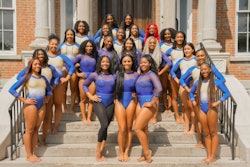The Latrell Sprewell-P.J. Carlesimo brouhaha that shook
professional basketball and the sports world has reverberated to the
collegiate level, where it has some wondering whether there should be
guidelines governing the behavior of coaches.
While no one even remotely condones Sprewell’s attack on Carlesimo,
there is evidence that it was precipitated by the verbal berating of
Sprewell by Carlesimo. Can coaches go too far? And if they do, what is
the appropriate response from younger, less mature college athletes?
“Yes, you can go overboard,” said Jim Haney, executive director of
the National Association of Basketball Coaches (NABC). “I think that
clearly there have been times and situations that make us question
whether a coach has crossed the line.
“To think that the relationship between coaches and players is not
an issue would be naive,” he continued. “In a tragic situation like
Sprewell’s, no one wins. But those of us on the outside can use that as
an opportunity to look at the misfortune of someone else and what we
can learn from it and what we can apply, because obviously we don’t
want to see ourselves in the same situation.”
Members of the NABC are expected to adhere to an association code
of ethics that calls, in part, for coaches to “treat all persons with
dignity and respect providing a model of fair play and sportsmanship.”
Despite that, there have been several documented incidents in
college sports over the years regarding coaches and their behavior
towards players — including a basketball coach fired for allegedly
using demeaning and vulgar language toward his players.
Then there is the basketball coach who was fired for using the “N”
word when referring to Black players. He tried to justify it as a
motivational tool.
Still another came under scrutiny for passing out tampons to his players to question their manhood.
And there is Bobby Knight, the legendary basketball coach at
Indiana University who is well known for tirades that have included
lashing out in public at players.
But Knight should not be singled out, Haney said, adding, “There
are people who are critical of Bob. There are also scores of players
who are advocates of Knight. I think it is true that every coach is
going to have those players that are very supportive, those who are in
the middle, and those who are not enthralled with the coach. But when
one evaluates the conduct of a coach, a little bit is in the eyes of
the beholder. So much of relationships are interpersonal — how we deal
with each other.”
Monitoring and Ethics
It is the nature of those relationships that needs to be
continually addressed, according to Haney and others who agree that the
competitive level of college sports has put more pressure on everyone
— coaches and players alike — to win. That pressure creates stress,
which in turn affects a coach’s behavior.
However, according to Haney, there is a monitoring system in place.
“I have always felt in college, quite frankly, how coaches interact
with players, how they treat players, is monitored in the recruiting
practices,” he said. “If a coach gets a reputation as player-friendly,
it is going to help recruiting. If a coach gets a reputation that this
is not the guy you want to play for, then the coach is going to have
difficulty recruiting student athletes. And that ultimately will impact
on the bottom line as it relates to wins and losses.
“Ultimately, a coach has the responsibility of creating a healthy
atmosphere,” Haney continued. “During the course of a season, there are
going to be storm clouds, and a coach must maintain a healthy, positive
environment so that his or her players and program can be successful.
There is a very strong sense of responsibility on the part of coaches
to create that environment, just like people who get married don’t want
to end up in divorce. But things do happen. Like married people, you
have to work at it, and work at it every day.”
In agreement is Dr. Thomas A. Crawford, director of coaching for
the U.S. Olympic Committee, which has required coaches to sign a code
of ethics for a couple of years. The code provides guidelines for what
is acceptable and unacceptable behavior by coaches. Unacceptable
behavior includes physical and verbal abuse.
However, Crawford admits that the concept of an ethical code is wide open for interpretation.
“A lot of coaches yell at athletes to motivate,” he said, “so it is
a very tricky area. I think the real key is that there be mutual
respect between athletes and coaches. But every single coach and
athlete are unique human beings and bring a unique philosophy to the
job every day, recognizing that they are under a tremendous amount of
pressure to perform.
“One of the greater challenges is motivating on a daily basis in
pursuit of excellence,” Crawford added. “When you play as many games as
athletes do today, the coaches’ job is to get athletes really ready to
play day after day — and that is hard.”
The U.S. Olympic Committee is trying to establish national
guidelines for coaches on ethics, safety, knowledge, and competency,
Crawford said, under the belief that “all coaches should know and be
able to do whatever they [must] to enable athletes to get better.
“Going into a rage is not making it better. Coaches have to realize
that,” advised Crawford, who noted that, given the win-and-win-now
attitude that coaches face, maintaining perspective is not an easy task.
“I think that it is time for university presidents and athletics
directors to back up what they say with policies that give coaches time
to develop programs that are good for the college as opposed to [the]
win-at-all-costs [attitude.] There are very few coaches who aren’t
genuinely interested in helping players develop — and not just as
athletes, but as human beings,” he said. “If the message they get is,
`win and win now,’ that is inconsistent with the mission of the
university.
However, that is no excuse for verbal abuse and physical attacks.
You hope that it doesn’t happen again, but there is a pressure cooker
in the world of sports that is certainly building. I believe that the
very best coaches are coaches that are really excellent communicators
and respect kids as human beings and do that while still pursuing
excellence.”
Dignity and Sensitivity
What that really boils down to is respect for the welfare of
student athletes, according to Charles Whitcomb, chair of the National
Collegiate Athletic Association (NCAA) Minority Opportunities and
Interests Committee, who acknowledged that some coaches do indeed step
over the line of acceptable conduct relative to players.
“I think there are a lot of coaching styles. Some coaches are
abrasive, some less abrasive, in theory of trying to motivate student
athletes,” he said. “Yes, I think [abuse] does exist, but I am not sure
it does exist at [the same] levels [as] in the Sprewell situation.”
Regardless, Whitcomb said, coaches and the institutions they serve
must “be sure we protect the rights and dignity of our men and women,
and behavior should not be tolerated that undignifies our student
athletes. If a professor of history acted in an offensive manner toward
a student, we wouldn’t tolerate it. We have to do the same thing to
protect our student athletes.”
This includes the need to be sensitive to the diversity of student
athletes with whom coaches work. Although most consider the Sprewell
situation was not racially motivated, race became an issue because
Sprewell is Black and Carlesimo is White.
“The more they can do to enhance their cultural awareness, the
better off they are going to be as coaches,” Whitcomb said. “You have
people who are African American, or are from Nigeria or Germany. There
are cultures and traditions that carry over. They don’t leave them at
home, they bring them with them.”
And that means taking those considerations into mind when deciding how to discipline a player.
“There are ways of correcting someone’s mistakes,” stated Whitcomb,
“and it might not be to do it in front of everyone. Sometimes it is the
way you do it, not what is said or how it is said.”
Dr. Lee A. McElroy, athletics director at American University and a
member of the NCAA Certification Committee, agreed, saying, “As
administrators, we have to do even more to train coaches in the area of
effective communications and sensitivity.”
Two of the areas the committee addresses are ethics and the welfare of student athletes.
Fairness and Consistency
Coaching is more complicated today, according to McElroy, with
increased media attention, pressure, and stress. Throw in having to
deal with fundraising and corporate relations, and the coach-athlete
relationship is further imperiled.
“If it goes sour, a lot of things can happen,” McElroy said, who
also noted that while abuse — or its potential — certainly exists,
athletes maintain their own fairness doctrine.
“First is consistency,” he said. “Discipline must be applied
consistently. If you scream and holler at everybody, that is one thing.
But if you scream at the guy at the end of the bench and hug the
starter, you will have problems.”
The second component of the fairness doctrine is the way discipline and criticism is delivered.
“Some people don’t want you in their face,” McElroy said. “They may
handle it better in an informal setting, yet some can handle a dressing
down in front of the team. How you do it is important.
“Third,” he concluded, “they want to make sure that when punished,
it is a deserved type of punishment — that the punishment fits the
crime.
But should a code of conduct be universally applied to ensure that athletes are treated fairly by coaches?
“It is a beautiful thing to say, but a code of conduct can’t be
enforced,” said Rudy Washington, athletics director at Compton
Community College and executive director of the Black Coaches
Association.
“How do you classify abuse?” he asked. “Some look at it as
motivation, some look at it as abuse. Back in the day when you spanked
kids, they needed a whipping. Now, it is child abuse.
“It is accepted in the coaching ranks that coaches get on players
and verbally really get after players. I don’t think, personally, that
degrading athletes and harassing an individual is called for, but it is
a tough line to draw,” Washington concluded. “Some people are [just]
more sensitive.”
COPYRIGHT 1998 Cox, Matthews & Associates
© Copyright 2005 by DiverseEducation.com



















